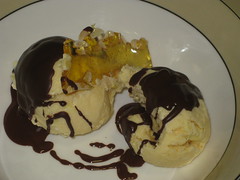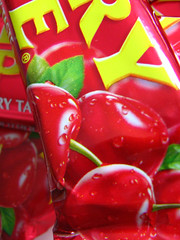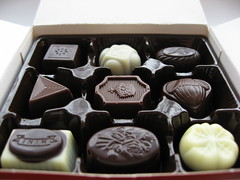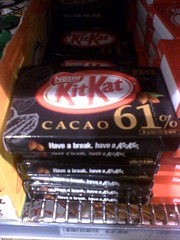 The other key part of the recipe from my “Recipe Club” dessert (the previous part being the Ice Magic) was the ice-cream itself. The main problem here for me is that I don’t currently have an ice-cream maker; the last one exploded in the pantry when it got too hot one summer. So, I needed to find a recipe that explained how to make it without one.
The other key part of the recipe from my “Recipe Club” dessert (the previous part being the Ice Magic) was the ice-cream itself. The main problem here for me is that I don’t currently have an ice-cream maker; the last one exploded in the pantry when it got too hot one summer. So, I needed to find a recipe that explained how to make it without one.
I was rescued by a recipe book called Ice Cream (of course) by Joanna Farrow and Sara Lewis. Sadly, this book has been in my possession for several years now without ever being used. It survived several house moves when other books were culled, and clearly there was method to the madness since it turned out to have exactly the sort of recipe that I was looking for.
Ingredients
4 egg yolks
75g caster sugar
1 teaspoon (5mL) corn flour
300mL milk
250g white chocolate (happily Whittakers still makes good chocolate in 250g blocks)
2 teaspoons (10mL) vanilla extract
300mL whipping cream (~35% milk fat)
Method
With the egg yolks, caster sugar and corn flour in a large bowl, stir with a fork until it is well combined and slightly bubbly.
Then pour the milk into a saucepan, place over a medium heat on the stove, and bring to the boil. Remove from the heat and drizzle into to egg mixture, stirring all the while, and you’ll end up with a basic custard mixture in the bowl.
If you’re like me, you’ll have ended up with milk cooked onto the bottom of the saucepan, and will need to get another one or do a quick clean.
Pour the custard mixture back into a saucepan, place over a low heat on the stove, and stir constantly until the mixture thickens, perhaps to the consistency of a pouring custard. It will also get really smooth at that point, which is another good indicator. Don’t try to over-thicken the custard.
Remove the custard from the heat, and pour into a large, freezer-proof bowl.
Break 150g of the white chocolate into small pieces. Then gently stir those pieces into the hot custard, along with the vanilla extract. Leave it to cool for 20 mins or so, and then place in the fridge to chill. This should take about another hour.
Put the cream into a bowl (yes, another one), and whip it with an electric beater until it has thickened, but “still falls from the spoon”. You should see the cream beginning to form little lumps at this point, and it will have doubled in volume.
Remove the bowl of chilled custard from the fridge, fold the whipped cream into it, and put it in the freezer for three hours.
Remove it from the freezer. Using a fork, pull the icecream away from the sides of the bowl. Then, using an electric beater, blend together the frozen and unfrozen parts of the mix for about a minute. The ice cream mixture should be the same consistency as a good milk-shake. Return to the freezer again for another two hours.
Finely chop the remaining white chocolate, so that the pieces are about the same size as choc bits.
Remove the ice cream from the freezer again. Follow the same approach as before with the fork and electric beater, and this time stir in the white chocolate as well. The ice cream mixture should be the same consistency as a thick-shake. Return to the freezer again for another two to four hours, or until firm.
Makes about 1L of ice-cream, so will serve about 8 if presented in cones or about 4 if presented in bowls.
 This is another easy and tasty slice from the Country Women’s Association slice cook-book. The first time I made this, I followed the recipe and used dried apricot, but this time I used crystalised ginger and it worked a treat.
This is another easy and tasty slice from the Country Women’s Association slice cook-book. The first time I made this, I followed the recipe and used dried apricot, but this time I used crystalised ginger and it worked a treat.

![Reblog this post [with Zemanta]](http://img.zemanta.com/reblog_e.png?x-id=2cde76bc-c83e-449f-a222-9b6fa7c7a2f4)

![Reblog this post [with Zemanta]](http://img.zemanta.com/reblog_e.png?x-id=db0e9548-6bd9-4f50-a328-d31d279c7242)

